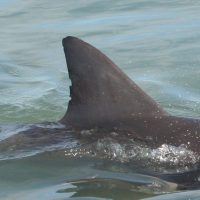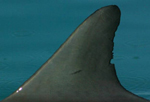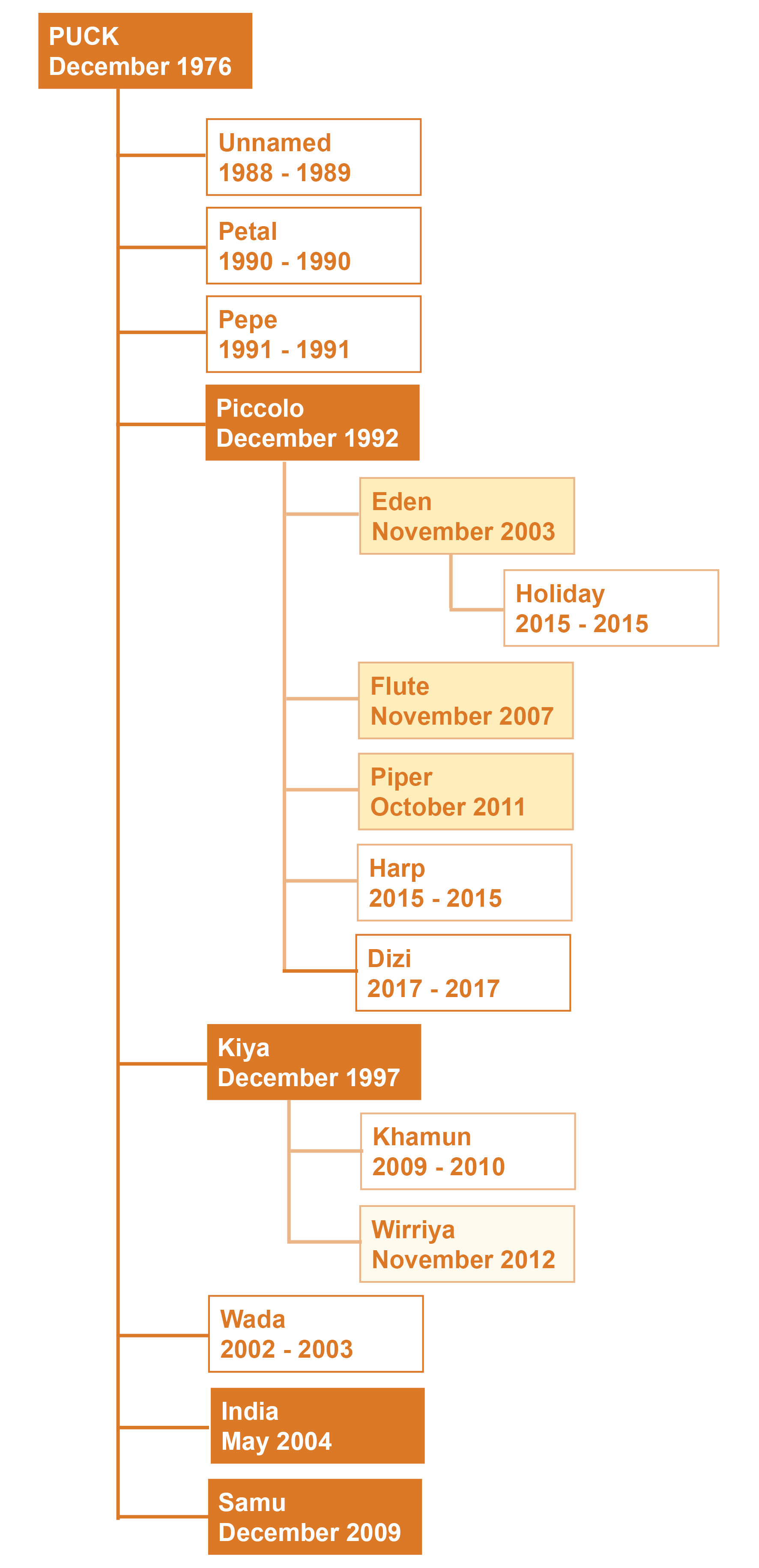Meet the Monkey Mia Dolphins
More than 2,000 dolphins inhabit Shark Bay and about 300 live in the waters around Monkey Mia. The dolphins at Monkey Mia are Indo-Pacific bottlenose dolphins, a sub-species of the common bottlenose dolphin.
Due to strict management regulations for the ongoing welfare of the dolphins only five adult females are fed at Monkey Mia. They can be identified by their dorsal fins and following is a little bit about each of them.
You can read more about the lives of Monkey Mia’s dolphins at the Dolphins of Monkey Mia Research Foundation.
Below are the family trees of the Monkey Mia beach visiting dolphins.
Puck
1976 – 2019
Daughter of Crookedfin

Puck was the daughter of Crookedfin, one of the original dolphins who began visiting the beach in the late 1970s. Puck was a regular visitor to the beach and well integrated into the larger community of female dolphins at Red Cliff Bay.
Members of Puck’s family have a close bond and spend most of their time socialising and foraging together. They are skilled at ‘rooster-tail’ foraging, a deep water technique that involves swimming fast and leaving a trail along the surface then backtracking and diving to catch their prey.
Puck birthed eight calves. Piccolo (06/12/1992) was Puck’s first calf to survive and now regularly visits the beach.
Puck’s next calf Kiya (13/12/1997) survived a shark attack in 1999. Puck’s other surviving calves are India (07/05/2004) and Samu (12/12/2009).
Most of the markings on Puck’s dorsal fin were the result of being entangled in fishing nets while chasing mullet in 1994.
Piccolo
Born 6 December 1992
Daughter of Puck

Piccolo is Puck’s fourth calf and was introduced to the beach program in 1999. Piccolo initially appeared more interested in offering the fish to the rangers than eating the fish herself. Piccolo still takes her time with food and will often show her fish to visitors before eventually swallowing it whole.
Piccolo’s first calf was Eden (20/11/2003) and her second calf, Flute (13/11/2007). Piccolo and Flute are sometimes seen in the afternoons foraging and chasing fish at impressive speeds along the shoreline at Monkey Mia. Dolphins can reach speeds of up to 40 km/hour when herding fish.
Genetic sampling has shown that Piccolo and Kiya have the same mother and father (Real Notch). Fathers do not associate with their offspring.
Piccolo’s fin has a 2cm-deep slit about 3cm below the tip and several other notches further down.
Kiya
Born 13 December 1997
Daughter of Puck
Sister of Piccolo

Kiya was introduced to the feeding program in 2016 but has been coming to the beach since she was born. She is the daughter of Puck and sister of Piccolo who are part of the dolphin experience program. Kiya had her first calf, Khamun (born 27/12/2009), when she was 12 years old.
Kiya’s movements at the beach had been recorded all her life and she was monitored extensively prior to being introduced to the feeding program. As a fully independent female with her own calf, Kiya’s survival skills were fully developed to the extent that it was considered safe to introduce her to the feeding program without risk to her health or that of her calf Wirriya (07/11/2012).
Surprise
1979 – 2019
Mother to Shadow, Shock,
Sparky, Burda, Shiver & Sonic

Surprise became a regular visitor to Monkey Mia in the late 1980s but did not accept fish until 1990. She was named for her tendency to suddenly appear at researchers’ boats for a bow ride. She also tended to appear unexpectedly during the morning interactions.
Surprise has birthed seven calves and four are still alive: Sparky (14/11/1998), Burda (21/01/2003), Shiver (30/11/2006) and Sonic (17/11/2010). The name ‘Sonic’ relates to a research project by Murdoch University and the University of Southern Denmark. Researchers use a hydrophone to record Sonic’s sound emissions to better understand how echolocation signals develop in young dolphins.
Surprise’s dorsal fin had a rounded tip and a few sharp notches midway down.
Shock
1994 – 2018
Daughter of Surprise

Shock was Surprise’s second calf and was introduced to the beach interaction program in 2006 when she was pregnant with her first calf. Like Surprise, Shock was sometimes an elusive dolphin, often preferring to remain at the back of the Dolphin Experience Area when visiting the beach.
Shock inherited Surprise’s impressive foraging skills – both were skilled at catching and eating flathead, a spiny fish common in the seagrass that few dolphins are able to catch and eat. Surprise and Shock spent a lot of time foraging in shallow waters on the flats northeast of Monkey Mia.
Shock’s dorsal fin had very few markings but could be identified by its arched shape.


